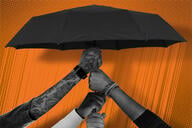You have /5 articles left.
Sign up for a free account or log in.
WASHINGTON -- Arguments for the value of the humanities have been thick on the ground of late, as the ongoing economic stress felt by students, institutions, and governments has bolstered a cultural shift in emphasis toward more evidently practical science and technology disciplines.
One venue that hasn’t seen such an argument -- at least in recent years -- is the annual Jefferson Lecture in the Humanities, billed as "the most prestigious honor the federal government bestows for distinguished intellectual achievement in the humanities.” One might well assume that both the National Endowment for the Humanities, which sponsors the lecture, and those who attend its events would take the humanities' importance for granted.
But in this year’s lecture -- delivered Monday night at the John F. Kennedy Center for the Performing Arts -- Walter Isaacson delivered a traditional defense of the humanities, arguing that they are “the wellsprings of our creativity”: the means for learning the “values, aesthetic judgments, social emotions, and personal consciousness” that remain unique to the human mind in a world increasingly reliant on the intelligence of computers.
Previous lecturers, by contrast, have tended to speak more specifically on their own area of specialty or academic discipline. Last year, director and filmmaker Martin Scorsese lectured on the importance of film conservation; the previous year, writer and conservationist Wendell Berry spoke out against environmental exploitation; and in 2011, Civil War historian and Harvard University President Drew Gilpin Faust discussed the impact of the way we construct war narratives.
Isaacson’s résumé includes stints as editor of Time magazine and chairman and CEO of CNN. Now president and CEO of the Aspen Institute, a nonprofit think tank and research organization, he is perhaps better-known as the author of a number of best-selling biographies, whose subjects have included Henry Kissinger, Benjamin Franklin, Albert Einstein, and Steve Jobs. (More on Isaacson's life and career may be found in the current issue of the NEH's magazine, Humanities, as well as on the blog of the Louisiana Endowment for the Humanities.)
In his lecture, "The Intersection of the Humanities and the Sciences," Isaacson drew heavily on the lives of the latter three men, as well as the 19th-century writer and mathematician Ada Lovelace, to argue that “people who can connect the arts to the sciences” have achieved some of the most important breakthroughs throughout history and will continue to be the most important innovators in “the next phase of the digital revolution.”
If the lecture’s message was familiar, so too were many of the anecdotes it comprised: that “Einstein was no Einstein when he was a kid,” and that he spent years working as a patent clerk before gaining recognition for his ideas; that Jobs’ famous aesthetic sense was inspired in part by a calligraphy course he audited after dropping out of Reed College.
What distinguished Isaacson’s lecture from so many other cases made on behalf of the humanities was its emphasis on “human-technology symbiosis,” which Isaacson believes will “help restore the link between the humanities and the sciences."
Isaacson outlined two possible ways of thinking about this symbiosis. The first is based on the ideas of 20th-century mathematician Alan Turing, famous for the idea of the "Turing Test" for judging whether machines can think. "The Turing approach," Isaacson said, "is that the ultimate goal of powerful computing is artificial intelligence: machines that can think on their own, that can learn and do everything that the human mind can do."
But Isaacson argued instead for what he called the "Lovelace approach," in which "the partnership between humans and technology will always be more powerful than purely artificial intelligence."
Lovelace, the daughter of famed Romantic poet Lord Byron, was an early proponent of collaboration between people and the machines they create (she referred to her own mindset as "poetical science"). To Isaacson, Lovelace represents the idea that the "originality and creativity" of humans will never be replicable by artificial intelligence; rather, "machines and humans will get smarter together, playing to each other's strengths and shoring up each other's weaknesses."
In the last half-century, Isaacson said, there have been incredible strides in human-computer collaboration, while "true artificial intelligence has remained a mirage, always about 20 years away." The Lovelace approach, in his view, remains by far the more productive of the two -- which means that the role of the humanities is as important as ever, if not more so.
As human intelligence is to that of computers, Isaacson suggested, so the humanities are to the sciences. "[I]f we are to retain our role as partners with our machines," he said, "we must continue to nurture the humanities.... That's what we bring to this party."
Monday night's crowd at the Kennedy Center was somewhat smaller than in the past few years (and grayer, too), but those in attendance were generally impressed, praising Isaacson's sense of humor and the connections he drew among disparate subjects. Isaacson gave a lively speech, diverting frequently and significantly from his prepared text, and he demonstrated a keen sense of comedic timing, such that his talk was frequently interrupted by loud, appreciative laughter.
Extolling the virtues of the humanities to the audience for the Jefferson Lecture is likely "singing to the choir," as Isaacson acknowledged. Still, at least a few audience members took issue with some of his points. At a reception after the lecture, one woman questioned whether the analogy between human and artificial intelligence, on the one hand, and the humanities and sciences, on the other, really holds up -- Isaacson, she said, had pushed that idea much too far.
Another attendee noted, via Twitter, that creativity is hardly the sole province of the humanities. "Science can also teach/make us marvel," she added.




